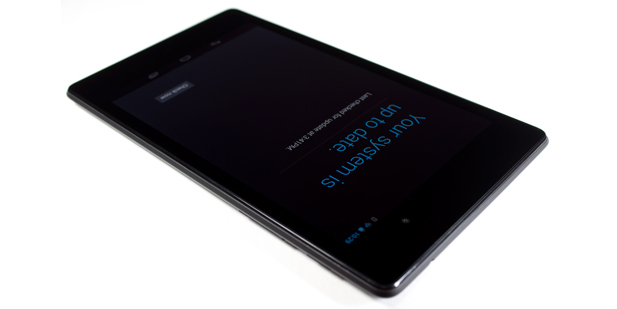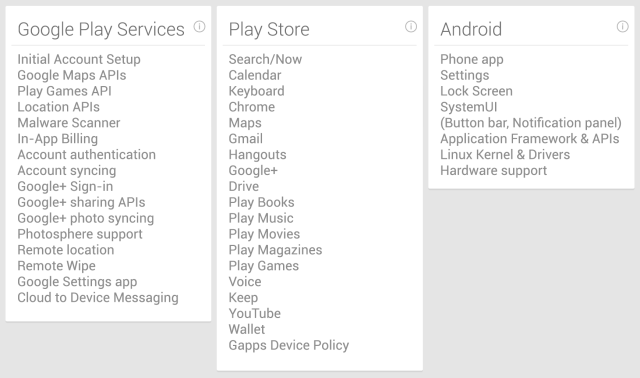
Android 4.3 was released to Nexus devices a little over a month ago, but, as is usual with Android updates, it's taking much longer to roll out the general public. Right now, a little over six percent of Android users have the latest version. And if you pay attention to the various Android forums out there, you may have noticed something: no one cares.
4.3's headline features are a new camera UI, restricted user profiles, and support for new versions of Bluetooth and OpenGL ES. Other than the camera, these are all extremely dull, low-level enhancements. It's not that Google is out of ideas, or the Android team is slowing down. Google has purposefully made every effort to make Android OS updates as boring as possible.

Why make boring updates? Because getting Samsung and the other OEMs to actually update their devices to the latest version of Android is extremely difficult. By the time the OEMs get the new version, port their skins over, ship a build to carriers, and the carriers finally push out the OTA update, many months pass. If the device isn't popular enough, this process doesn't happen at all. Updating a phone is a massive project involving several companies, none of which seem to be very committed to the process or in much of a hurry to get it done.
Since it's really hard to push out an Android update, Google's solution is to sidestep the process completely. The company stopped putting all the good stuff in Android updates. It's not that good stuff isn't coming out at all, the exciting features are just not being included as part of a big Android release.
This year's Google I/O was a show of force for this new delivery concept. No new Android version was at the show, yet Google announced Google Hangouts, Google Play Games, cloud saving of game and app data, a complete redesign of Google Play Music and Google Maps, a new version of the Google Maps API, and new location and activity recognition APIs. Post I/O, we've seen seemingly OS-level features added like the Android Device Manager, a remote wipe and device tracking system, without needing to touch the base OS.
It's such a simple idea: Android updates roll out too slowly, so start releasing all the cool stuff separately. The hard part is making it actually work. But the first reason this is now possible is a little app that has finally come of age: "Google Play Services."

Calling Play Services an "app" doesn't really tell the whole story. For starters, it has an insane amount of permissions. It's basically a system-level process, and if the above list isn't enough for whatever it needs to do next, it can actually give itself more permissions without the user's consent. Play Services constantly runs in the background of every Android phone, and nearly every Google app relies on it to function. It's updatable, but it doesn't update through the Play Store like every other app. It has its own silent, automatic update mechanism that the user has no control over. In fact, most of the time the user never even knows an update has happened. The reason for the complete and absolute power this app has is simple: Google Play Services is Google's new platform.

Andrew Cunningham looked at this shortly after Google I/O, but now things are truly crystallizing. Google's strategy is clear. Play Services has system-level powers, but it's updatable. It's part of the Google apps package, so it's not open source. OEMs are not allowed to modify it, making it completely under Google's control. Play Services basically acts as a shim between the normal apps and the installed Android OS. Right now Play Services handles the Google Maps API, Google Account syncing, remote wipe, push messages, the Play Games back end, and many other duties. If you ever question the power of Google Play Services, try disabling it. Nearly every Google App on your device will break.

The reason for all the permissions and sneaky updates is best illustrated in that chart above. While the latest version of Android is on six percent of devices, Play Services rolls out to everyone in a week or two and works all the way back to Android 2.2. That means any phone that is three years old or newer has the latest version of Google Play Services. According to Google's current Android statistics, that's 98.7 percent of active devices. So at Google I/O, when Google announced their slew of new APIs, nearly every Android device was immediately compatible in a week. Play Services is a direct line from Google to the core of your phone, and, really, no one outside of Google is quite sure of just how powerful it can get.
Google Play Services takes care of lower-level APIs and background services, and the other part of Google's fragmentation takedown plan involves the Play Store. Google has been on a multi-year mission to decouple just about every non-system app from the OS for easy updating on the Play Store. Take a quick look at Google's Play Store account and you'll see a huge list of apps, many of which ship by default in Android. Gmail, Maps, Search, Chrome, Calendar, the keyboard, YouTube, and even the Play Store itself are all separately updatable.

The above list is a good representation of the current update situation in Android. Nearly everything that can be moved out of the main OS has been. The only features left that would require an OS update are things like hardware support, Application Frameworks APIs, and Apps that require a certain level of security or access (like the lock screen, Phone, and Settings apps).
This is how you beat software fragmentation. When you can update just about anything without having to push out a new Android version, you have fewer and fewer reasons to bother calling up Samsung and begging them to work on a new update. When the new version of Android brings nothing other than low-level future-proofing, users stop caring about the update.
This gets even more interesting when you consider the implications for future versions of Android. What will the next version of Android have? Well, what is left for it to have? Android is now on more of a steady, continual improvement track than an all-at-once opening of the floodgates like we last saw with Android 4.1. It seems like Google has been slowly moving down this path for some time; the last three releases have all kept the name "Jelly Bean." Huge, monolithic Android OS updates are probably over—"extinct" may be a more appropriate term.
Not having to package everything into a major OS update means Google can get features out to more users much faster and more frequently than before. Android feature releases can now work just like Google's Web app updates: silent, continual improvement that happens in the background. Your device is constantly getting better without your having to do anything or wait for a third party, and developers can take advantage of new APIs without having to wait for the install base to catch up. This should all lead to a more unified, less fragmented, healthier Android ecosystem.
reader comments
229